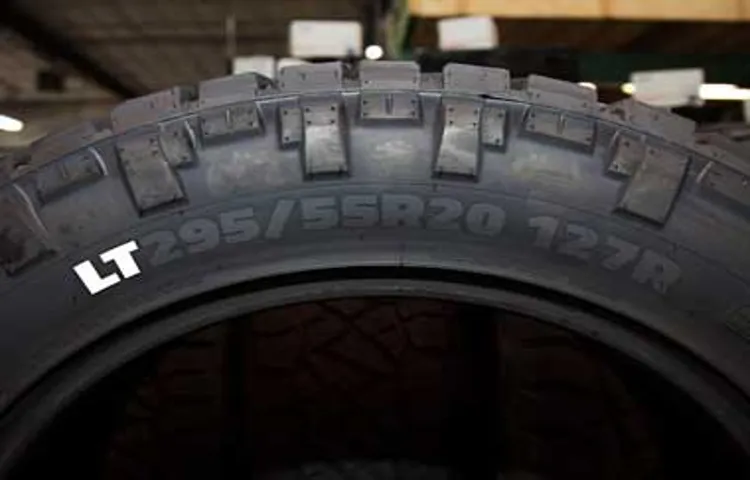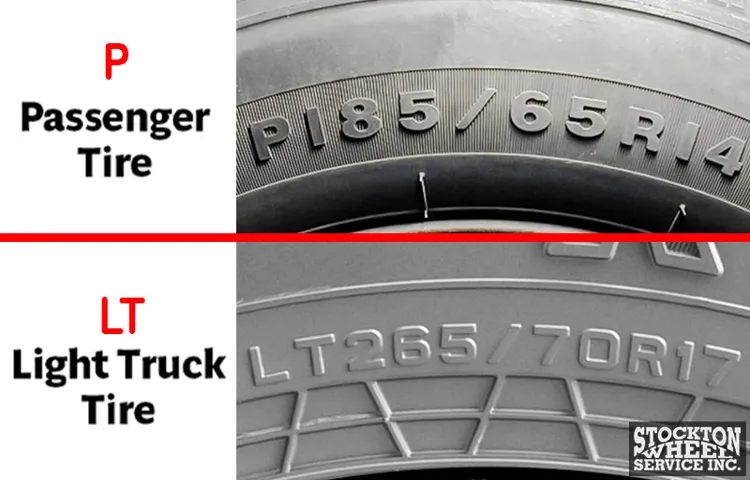Have you ever looked at the sidewall of your tire and wondered what all those letters and numbers mean? One of the most perplexing combinations is “LT,” which can often be found on the sidewalls of truck and SUV tires. What is LT? And why is it there? In this blog post, we’ll explore the meaning of LT on a tire and what it signifies for your vehicle. By the end, you’ll have a better understanding of what those letters mean and how they impact your driving experience.
So, buckle up and let’s dive in!
Understanding Tire Ratings
If you’re shopping for tires, you may have seen the letters “LT” on some of the options. This stands for “Light Truck,” and indicates that the tire is designed for use on trucks, SUVs, and other types of light-duty vehicles. LT tires are typically constructed to handle heavier loads and provide better stability than standard passenger car tires.
They also have a higher load range, which means they can carry more weight at higher speeds without becoming damaged or experiencing premature wear. If you own a light truck or SUV, it’s important to choose the correct tire for your vehicle to ensure proper performance and safety. Take time to research tire options and ratings before making a purchase to ensure you’re getting the best product for your needs.
Load Index and Speed Rating
Understanding tire ratings is essential for any vehicle owner. One crucial aspect of tire ratings is Load Index and Speed Rating. Load Index is a measurement of how much weight the tire can hold safely.
The higher the Load Index number, the larger the weight capacity of the tire. Speed Rating, on the other hand, indicates the maximum speed a tire can handle safely. The maximum speed rating is also represented by a letter, with “Q” being the lowest and “Y” being the highest.
It is crucial to ensure that your tires have load and speed ratings that are appropriate for your vehicle. Failure to do so could result in unsafe driving conditions and potential accidents. Checking your vehicle’s manufacturer’s recommended tire rating and contacting a tire professional can help ensure that you have the right tires for your vehicle and are driving safely on the road.

What LT Stands For
If you’ve ever looked at the sidewall of a tire, you might have noticed a designation of “LT” followed by some numbers and letters. But what does LT stand for on a tire? The answer is simple: LT stands for Light Truck, indicating that the tire is designed for use on light-duty trucks, SUVs, and vans. While passenger vehicle tires may also fit these types of vehicles, they may not be able to handle the weight and demands of the vehicle as well as an LT tire.
LT tires are typically designed with heavier and more durable materials to withstand the weight of these vehicles and provide better traction and handling. So if you have a light truck, SUV, or van, be sure to look for tires with the LT designation to ensure you have the appropriate level of durability and safety for your vehicle.
LT vs. P-Metric Tires
If you have ever shopped for tires, you have likely come across the term “LT” and wondered what it stands for. LT stands for “Light Truck,” and it refers to a specific tire designed for vehicles such as pickup trucks, vans, and SUVs. These tires are built for heavy loads and tough terrain, making them ideal for vehicles used for work or outdoor activities.
On the other hand, P-Metric tires refer to Passenger Metric tires, which are designed for passenger cars, minivans, and some smaller SUVs. They are less rugged than LT tires but provide a smoother and quieter ride. When choosing between LT and P-Metric tires, it’s important to consider your vehicle’s specific needs, such as the weight and type of cargo it will regularly carry, as well as the driving conditions you typically encounter.
This can help you determine which type of tire is best suited for your vehicle and driving needs.
Benefits of LT Tires
LT stands for “Light Truck” on a tire, indicating that the tire is designed for trucks and SUVs that carry heavy loads or tow trailers. LT tires offer numerous benefits, including increased carrying capacity, improved handling and stability, and better traction on rough terrain. They also have thicker sidewalls than regular tires, which helps prevent punctures and blowouts.
LT tires have a longer lifespan than regular tires and can handle more heavy use. They are also more durable and can withstand harsh weather conditions. If you own a truck or SUV and need to carry heavy loads or tow trailers, it is a good idea to invest in LT tires to ensure safety and optimal performance on the road.
Off-Road Capabilities
Off-Road CapabilitiesAre you looking to enhance your off-road capabilities? Then consider upgrading to LT tires. LT tires, or Light Truck tires, are designed specifically for trucks and SUVs, providing superior performance on rough terrain. They have a reinforced construction and thicker sidewalls compared to passenger tires, allowing for heavier loads and increased durability.
LT tires have a higher load carrying capacity and towing capabilities, making them ideal for off-road adventures. Plus, they provide excellent grip and traction on all types of terrain, including mud, rock, and sand. So, whether you’re headed to the mountains or the beach, LT tires can help you tackle any rough terrain with ease.
Upgrade to LT tires today and experience the benefits of improved off-road capabilities.
Conclusion
We’ve finally come to the rubbery end of our inquiry into what LT stands for on a tire. And as it turns out, it’s not just a mere abbreviation for Light Truck – it’s a symbol of strength, durability, and reliability, the three essential qualities that all drivers seek in their vehicle’s tires. So the next time you hit the road, take comfort in knowing that your LT tires are ready to take on any challenge, from rough terrain to heavy loads.
In short, LT stands for trust, peace of mind, and road dominance!”
FAQs
What is the significance of the LT on tire markings?
The LT stands for “Light Truck” and indicates that the tire is designed for use on light trucks or SUVs.
Can passenger car tires be used on light trucks instead of LT tires?
While it may be possible, it is not recommended as passenger car tires do not have the same weight capacity as LT tires.
What are the benefits of using LT tires over passenger car tires on light trucks and SUVs?
LT tires have a higher load carrying capacity, which means they can handle the weight of a light truck or SUV better than passenger car tires. They also have stronger sidewalls for better stability and durability.
Do all light trucks and SUVs need to use LT tires?
It is not necessarily mandatory for all light trucks and SUVs to use LT tires, but it is recommended for optimal performance and safety.
How do you know if your light truck or SUV needs LT tires?
Check your vehicle owner’s manual or consult with a tire professional to determine the recommended tire type and size for your specific vehicle.
Are LT tires more expensive than passenger car tires?
Generally, yes. LT tires are designed for heavier vehicles and have additional features such as stronger sidewalls, which can make them more expensive than passenger car tires.
Can LT tires be used in place of passenger car tires on a regular car?
While it is possible, it is not recommended as LT tires may have a rougher ride and could affect the handling of the vehicle. It is important to use the correct tire type and size for your specific vehicle.

